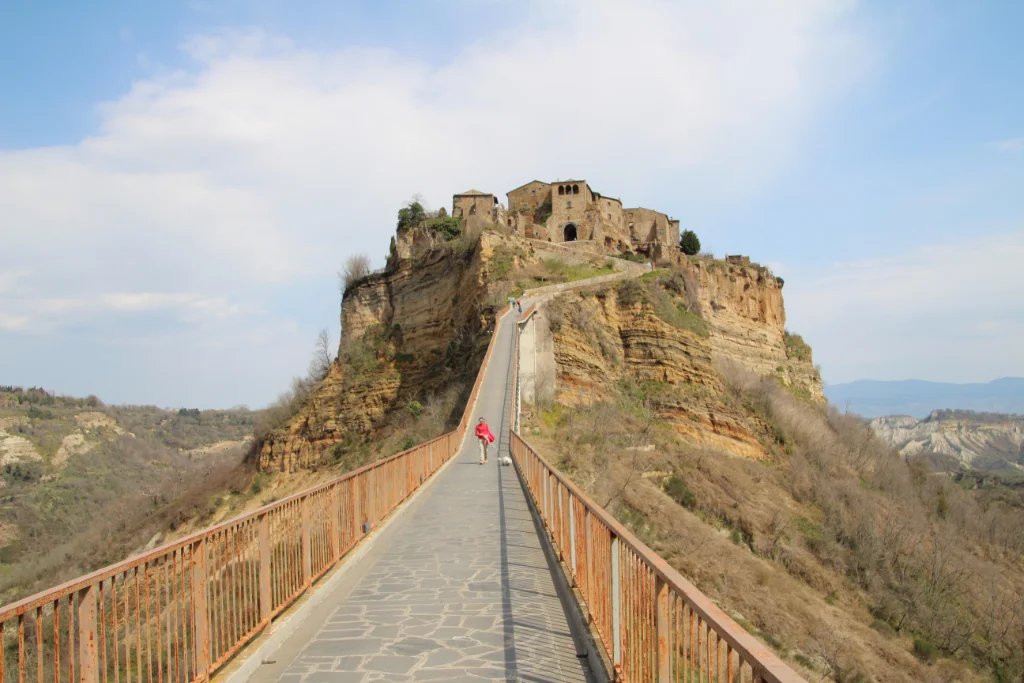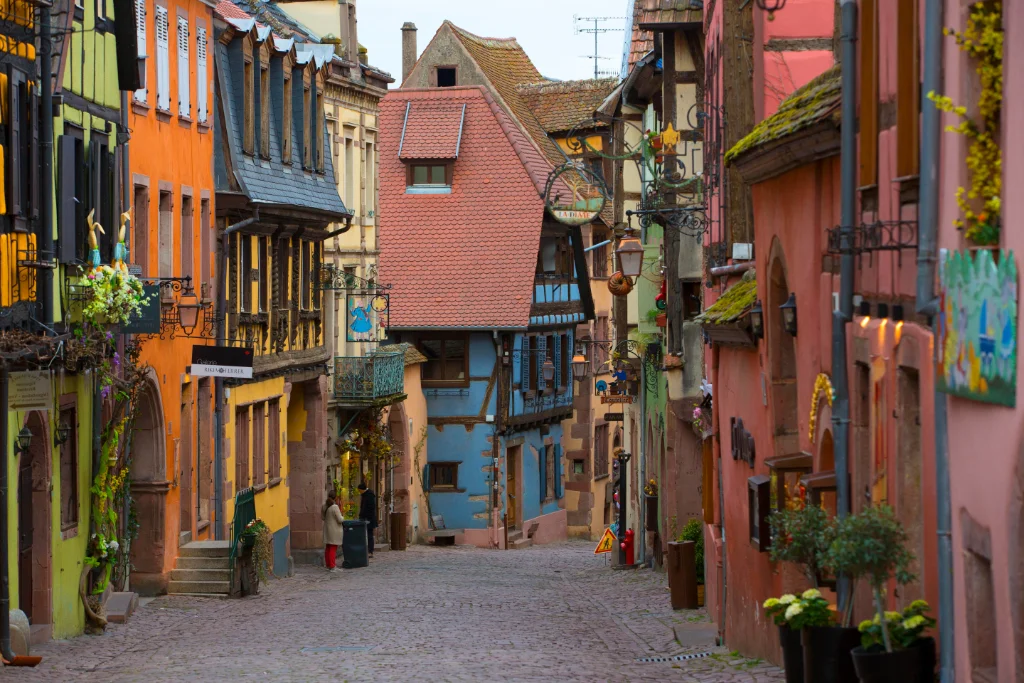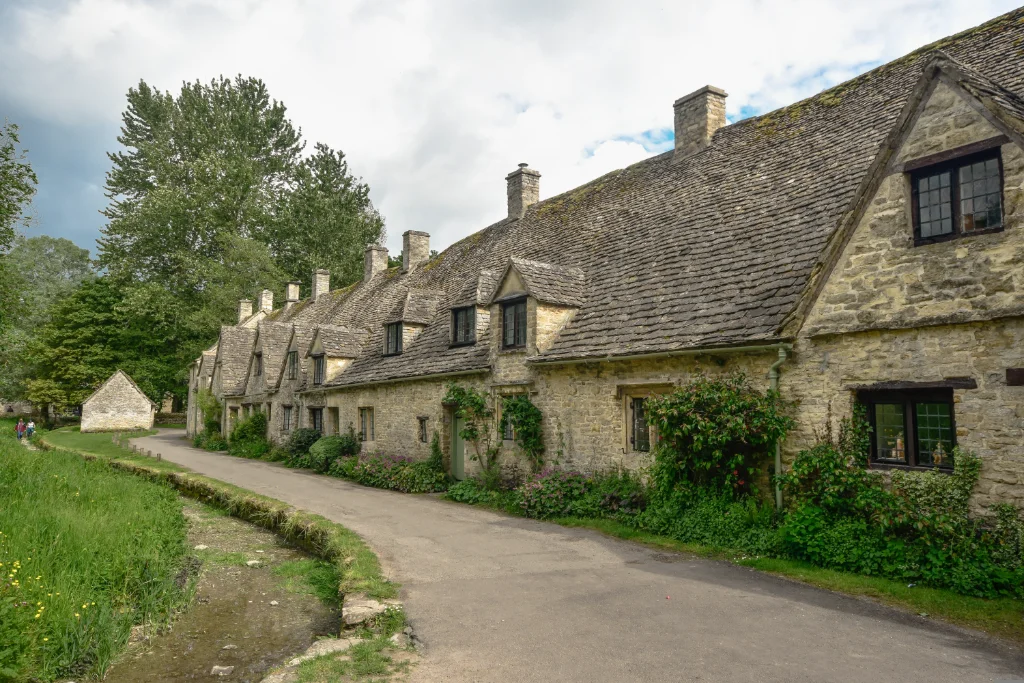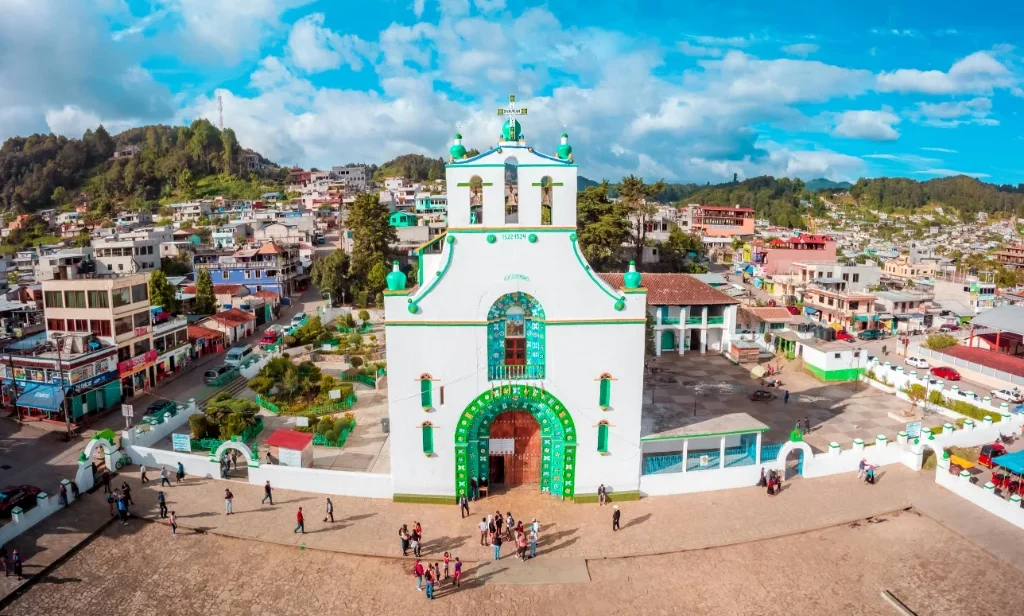Perched on a hill in the heart of Italy’s Lazio region, Civita di Bagnoregio is a captivating example of medieval architecture frozen in time. Known as “la città che muore” or “the dying city,” this enchanting village stands dramatically above the erosion-sculpted Valle dei Calanchi. With origins stretching back over 2,500 years to the Etruscans, Civita’s secluded location has helped preserve its ancient buildings and narrow streets, offering a window into a distant past.
Accessible solely by a pedestrian bridge, the approach to Civita di Bagnoregio reveals a village that seems to float in the sky, its existence defying the deep canyons below. Let’s embark on a journey through the historic gates of Civita, exploring its rich history and the compelling beauty that makes it an essential destination for those exploring Italy’s rich cultural heritage.
Where is Civita di Bagnoregio Located ?
Civita di Bagnoregio is situated in the Lazio region of central Italy, nestled within the province of Viterbo. This enchanting town, perched atop a hill, overlooks the scenic Tiber river valley and is famed for its captivating landscape.
Located approximately 120 kilometers north of Rome and about 22 kilometers northeast of Orvieto, Civita di Bagnoregio offers easy access for travelers visiting the capital or exploring the nearby regions of Lazio and Umbria.
The town’s distinctive position above the Valle dei Calanchi, accessible solely by a pedestrian bridge, enhances its historic charm and draws visitors eager to explore a piece of ancient Italy in a breathtaking natural setting.
How to travel to Civita di Bagnoregio ?
1. By Air :
The nearest airports to Civita di Bagnoregio are Rome’s Fiumicino Airport and Ciampino Airport. From either airport, you can rent a car or take a train to continue your journey towards Civita. The drive from Rome to Civita di Bagnoregio typically takes about 1.5 to 2 hours.
2. By Train :
The closest major train station is in Orvieto, about 22 kilometers from Civita di Bagnoregio. Train travel from major Italian cities like Rome to Orvieto is quite frequent and affordable, with tickets generally ranging from €10 to €30 depending on the class and time of booking. The journey from Rome to Orvieto by train takes approximately 1 hour.
3. By Car :
Driving is perhaps the most convenient way to reach Civita di Bagnoregio. From Rome, take the A1 motorway towards Florence and exit at Orvieto. From there, local roads lead to Bagnoregio. Parking is available near the footbridge to Civita, with a parking fee of about €5, which can vary during peak tourist seasons.
4. By Bus :
There are bus services from Orvieto to Bagnoregio, although they may not be very frequent. The bus journey can take about 30 minutes and offers a scenic route through the Italian countryside. Tickets are inexpensive, typically costing around €2 to €3.
Another convenient option is to book an organized tour, especially if you’re unfamiliar with the area or prefer not to handle travel arrangements yourself. Many tours include transportation from major cities and provide guided experiences in Civita di Bagnoregio.
Cost-Effective Travel Tips for Civita di Bagnoregio
- Opt for a train to Orvieto followed by a local bus to Bagnoregio, which can be cheaper than direct private transfers.
- Buy Round-Trip Tickets, These are often less expensive than two one-way fares.
- Visit early in the morning or late afternoon to dodge peak fares and crowds.
- If you are traveling in a group, consider renting a car together from Rome or Orvieto to save on costs.
- Avoid high prices at tourist spots by carrying your own snacks and water.
Discover Civita di Bagnoregio :
1. What is the History of Civita di Bagnoregio ?
Civita di Bagnoregio, known as “the dying city,” boasts a profound history that dates back to the Etruscan period around 500 BC. Initially flourishing as an Etruscan settlement along a vital trade route, its historical significance grew due to its strategic locale.
During the Roman-Etruscan Wars in 265 BC, Civita di Bagnoregio came under Roman rule. The Romans enhanced the region by continuing the Etruscan-initiated infrastructure projects like rainwater drainage and stream containment. The area was so revered that during the Lombard period, it was renamed ‘Balneum Regis’ (The Bath of the King) by the Lombard King Desiderius, recognizing the therapeutic properties of the local hot springs (Wikipedia) (Ancient Origins).
Over the centuries, control shifted from the Goths and Byzantines to the Lombards and eventually the Franks under Charlemagne. By the 12th century, Civita di Bagnoregio was established as a free commune, though it remained under the influence of the nearby city of Orvieto. This era was marked by significant cultural and artistic development (Civita di Bagnoregio) (HeritageDaily – Archaeology News).
Saint Bonaventure, born here in 1221, added to the town’s historical and spiritual significance as a key theologian and figure in the Franciscan Order. Despite being devastated by a plague in the 14th century, the town achieved a remarkable recovery in the 15th century, only to face decline from major earthquakes in the 17th century which led many to abandon it (Ancient Origins) (Civita di Bagnoregio).
Today, Civita di Bagnoregio is known for its stunning medieval architecture and the dramatic erosion of its landscape, which has earned it the nickname “the dying city.” Despite its challenges, including being home to only a few permanent residents, it remains a popular tourist destination, attracting those drawn to its picturesque and historical allure (Wikipedia) (Ancient Origins).
2. How is the weather throughout the year in Civita di Bagnoregio ?
Civita di Bagnoregio experiences a temperate Mediterranean climate, characterized by mild, wet winters and hot, dry summers. Here’s a general breakdown of the weather throughout the year:
Spring (March to May): This season sees a gradual warming with temperatures typically ranging from 10°C (50°F) to 18°C (65°F). Rainfall decreases as the season progresses, making it a pleasant time for visiting with the countryside in full bloom.
Summer (June to August): Summers are warm and dry, with temperatures often climbing above 30°C (86°F). July and August can be particularly hot, making early morning or late evening the best times for exploring to avoid the midday heat.
Autumn (September to November): Similar to spring, autumn sees mild temperatures which gradually cool down from 25°C (77°F) in September to around 10°C (50°F) in November. This is a great time to visit as the crowds lessen and the landscape turns vibrant with autumn colors.
Winter (December to February): Winters are the wettest and coolest time of the year, with temperatures often between 1°C (34°F) and 10°C (50°F). Snow is rare, but the weather can be quite cold, especially in January and February.
The varied climate means that Civita di Bagnoregio can be enjoyed year-round, but spring and autumn offer the most temperate weather for outdoor activities and exploring the town’s charming streets and surrounding nature.
3. How is the geography like in Civita di Bagnoregio ?
Civita di Bagnoregio is perched on a hill in a stunning, precarious position above the Valle dei Calanchi in central Italy. The town sits on a plateau of volcanic tuff, a type of rock formed from volcanic ash, which contributes to the area’s unique and fragile geological structure. The elevation of Civita di Bagnoregio is approximately 443 meters (1,453 feet) above sea level.
The geography of this area is characterized by dramatic cliffs and deep valleys formed by erosion and seismic activity. This ongoing erosion has led to Civita di Bagnoregio being known as “the dying city,” as parts of the cliff face and edges of the plateau continue to fall away, leaving the town increasingly isolated atop its narrowing pinnacle. The only access to the town is via a pedestrian bridge, emphasizing its isolation and the dramatic nature of its landscape.
3 Tips to Find a Local Guide in Civita di Bagnoregio :
Finding a local guide in Civita di Bagnoregio can greatly enhance your visit, providing deeper insights into its history, architecture, and culture.
Here are some tips to help you find a reliable guide:
The first place to check is the Civita di Bagnoregio Tourist Information Center. They can provide recommendations for certified local guides who offer tours in various languages.
2. Online Platforms :
Websites like GetYourGuide and Viator offer a range of guided tour options with user reviews and ratings. You can book tours directly through these platforms, with options often available for both group and private tours.
3. Ask Your Accommodation :
Hotel staff are often a great resource for local recommendations. They can suggest guides who specialize in the type of tour you’re interested in, whether it’s focused on history, nature, or photography.
6 Must-Do Activities in Civita di Bagnoregio :
1. Explore the Pedestrian Bridge :
The pedestrian bridge to Civita di Bagnoregio, known as the “gateway to the dying city,” is an iconic symbol of this historic town. This bridge is the only access to Civita, stretching across a steep chasm formed by erosion. The walk across offers stunning views of the dramatic landscape below and the ancient village ahead, serving as a physical and symbolic journey into Civita’s secluded world.
Constructed to ensure the town remains accessible despite the ongoing erosion of the hill it’s perched on, the bridge also highlights the fragility and timeless beauty of Civita di Bagnoregio. It’s an essential part of any visit, providing a unique perspective and the perfect vantage point for photos, especially during the golden hours of sunrise or sunset when the valley and the town are bathed in ethereal light.
For additional information on the pedestrian bridge, including its history and visitor tips, you can refer to local tourism websites such as Visit Italy, which offer comprehensive guides and details about Civita di Bagnoregio.
2. Visit San Donato Church :
San Donato Church is a must-visit landmark in Civita di Bagnoregio, standing prominently in the main square of the village. This historic church is dedicated to Saint Donatus and serves as the spiritual heart of Civita. It features a Romanesque architectural style, typical of the medieval period, and offers a serene atmosphere that reflects its centuries of religious significance.
The interior of the church houses several notable artworks, including a beautifully decorated wooden crucifix and frescoes that depict various religious scenes. The church’s architecture and art are reflective of the rich cultural heritage of the region, preserved through the tumultuous periods of its history.
San Donato Church is not only a place of worship but also a significant historical site that provides visitors with a deeper understanding of Civita di Bagnoregio’s past. Its location in the piazza makes it a central starting point for further exploration of the village’s charming streets and ancient buildings.
3. Wander Through the Ancient Streets :
Exploring the ancient streets of Civita di Bagnoregio is like stepping back in time. This mesmerizing town offers a maze of narrow cobblestone pathways, flanked by centuries-old buildings made from the same volcanic tuff that forms the hill on which the town is perched. Each turn and corner brings its own slice of history and architectural marvel, from Renaissance-era palazzos to modest medieval homes, all preserved in their original splendor due to the town’s isolation and reduced modern development.
As you walk these streets, you’ll feel the layers of history beneath your feet. The town’s layout, largely unchanged for hundreds of years, reflects the adaptability of its residents to the challenging terrain and their dedication to preserving their heritage. The streets sometimes lead to terraces offering expansive views of the surrounding Calanchi valley, providing breathtaking scenes that make perfect photo opportunities.
4. Geological and Architectural Tours :
Geological and Architectural tours in Civita di Bagnoregio provide a comprehensive look at how natural forces and historical development have shaped this unique town. These tours explore the region’s geology, particularly the volcanic tuff, a soft rock formed from volcanic ash, that makes up the town’s foundation.
This material is central to understanding Civita’s susceptibility to erosion and its architectural resilience.
Tours also cover the blend of medieval and Renaissance architecture evident in structures like the Church of San Donato, highlighting the town’s ability to withstand the test of time amidst challenging environmental conditions.
Through these guided experiences, visitors gain insight into the ongoing preservation efforts that maintain Civita di Bagnoregio’s charm and historical significance.
5. Hike around Civita di Bagnoregio :
Hiking around Civita di Bagnoregio offers a unique opportunity to explore the stunning landscapes and geological formations that surround this ancient town. The area’s trails provide panoramic views of the Valle dei Calanchi, characterized by its dramatic clay hills and deep ravines formed by erosion.
Hiking Trails:
Civita Surrounding Trails : There are several trails around Civita di Bagnoregio that offer different perspectives of the town and the valley. These trails vary in difficulty, but most provide a moderate hike suitable for those with basic hiking experience. The paths take hikers through the unique badlands terrain, offering breathtaking views of Civita perched atop its plateau.
Bridge to Civita Walk : The pedestrian bridge to Civita itself provides a gentle, scenic walk. While not a hike in the traditional sense, walking this bridge is a must-do for any visit, as it offers unobstructed views of the town’s precarious position atop the eroding hill.
Calanchi Valley Exploration : For those interested in longer hikes, the trails extending into the Calanchi Valley offer more rigorous routes. These trails delve deeper into the natural and erosive processes that have shaped the landscape, giving hikers a close-up view of the valley’s unique geological features.
Preparation and Tips:
- Wear appropriate footwear: The terrain can be uneven and occasionally steep, so sturdy hiking shoes are recommended.
- Check weather conditions: Weather can change quickly, and some trails may be less accessible after rain due to muddy conditions.
- Bring water and snacks: There are few amenities outside of the town, so it’s important to carry sufficient water and some snacks.
- Respect the environment: The area’s unique geology is delicate. Stick to marked trails to avoid causing unnecessary erosion.
6. Experience a Local Festival :
Experiencing a local festival in Civita di Bagnoregio offers a vibrant immersion into the town’s cultural heritage. These annual summer events celebrate Civita’s rich history and traditions with a lively mix of music, dance, art exhibitions, and culinary delights.
Visitors can enjoy live traditional and regional music, watch folk dancing, and explore crafts made by local artisans. The festivals also feature delicious local cuisine, highlighting fresh, regional ingredients and wines.
For detailed information on participating in these events, please refer to our section “6 must-see Events and Festivals in Civita di Bagnoregio” where you can find additional details.
5 Unique Crafts and Products in Civita di Bagnoregio :
1. Ceramics and Pottery :
Local artisans create a variety of hand-painted ceramics, from functional kitchenware like plates and bowls to decorative items such as vases. These pieces often feature traditional designs or picturesque scenes inspired by the local landscape, making them popular souvenirs for visitors.
2. Olive Oil :
Olive Oil production is a pride of Civita di Bagnoregio, thanks to the fertile soils of the surrounding areas. The olive oil here is celebrated for its rich, robust flavor, often extracted using traditional methods that have been preserved over generations. This high-quality oil is a staple in local cuisine and a cherished take-home product for many tourists.
3. Wine :
The volcanic soil and favorable climate of the surrounding area makes Civita di Bagnoregio a prime spot for vineyards. Local wineries produce exquisite wines, typically using native grape varieties that contribute to the distinct taste profiles unique to this region.
4. Textiles :
Artisans in Civita di Bagnoregio also engage in textile production, creating handwoven goods that range from clothing to home textiles. These often feature traditional designs and are made using natural fibers, reflecting the area’s commitment to sustainable and traditional craft practices.
5. Artwork and Sculptures :
The town’s dramatic setting and historical ambiance inspire many local artists and sculptors, whose works capture the essence of Civita di Bagnoregio. Their artwork and sculptures can be found in local galleries and shops, offering visitors a chance to take home a piece of the town’s artistic legacy.
8 Signature Dishes and Restaurant Recommendations in Civita di Bagnoregio :
1. Antico Forno di Civita :
Located in the heart of Civita di Bagnoregio, this quaint restaurant is famed for its traditional Italian breads baked in a centuries-old oven. Signature dishes include their rustic pizzas and the celebrated “Pane di Civita,” a local bread that perfectly complements any meal.
2. Hosteria del Ponte :
Situated just before the bridge leading into Civita, Hosteria del Ponte offers panoramic views of the surrounding valley. The restaurant is renowned for its “Pappardelle al Cinghiale,” a rich and savory wild boar pasta, and the “Bruschetta al Pomodoro,” a fresh, flavorful starter.
3. La Piazzetta :
Location : San Cristóbal de las Casas
Signature Dish : Sopa de Pan – A tomato-based broth enriched with spices, filled with layers of sliced bread, capers, and olives.
4. Comedor Mary :
Nestled in the square of Civita di Bagnoregio, La Piazzetta serves up traditional Italian cuisine with a focus on local ingredients. Their signature dish, “Risotto con Porcini e Tartufo,” combines aromatic porcini mushrooms and truffle, making it a must-try for visitors.
5. Il Vecchio Mulino:
Just outside of Civita, Il Vecchio Mulino is known for its charming rustic setting and its “Bistecca alla Fiorentina,” a T-bone steak cooked to perfection over an open flame. They also offer a superb “Tiramisu” that is popular among locals and tourists alike.
6. Ristorante Al Forno di Agnese :
Tucked away in a picturesque corner of Civita di Bagnoregio, Ristorante Al Forno di Agnese is a favorite for its authentic local cuisine. The restaurant’s signature dish, “Gnocchi al Tartufo,” features handmade gnocchi with a rich truffle sauce that captures the essence of the region’s flavors.
7. Cantina di Arianna :
Located near the entrance of the town, Cantina di Arianna offers a cozy dining experience with its cellar-like ambiance. Patrons particularly enjoy the “Pollo alla Cacciatora,” a hearty chicken dish slow-cooked with herbs and local wine, and the “Insalata di Orto,” a fresh garden salad sourced from local ingredients.
8. Osteria del Borgo :
With its panoramic terrace views, Osteria del Borgo provides a perfect setting to enjoy a meal while overlooking the stunning landscape of Civita di Bagnoregio. Their “Filetto di Manzo al Pepe Verde,” a tender beef fillet in a green peppercorn sauce, is highly recommended, as well as their “Panna Cotta,” a creamy dessert that ends your meal on a sweet note.
6 must-see Events and Festivals in Civita di Bagnoregio:
1. Palio della Tonna (First Sunday in August and Second in September) :
This traditional event features a thrilling donkey race through Civita’s main square, drawing locals and tourists alike to partake in the festive atmosphere. The race is a highlight of the town’s social calendar and offers a glimpse into the local customs and community spirit.
2. Wild Donkey Races (June and September) :
Similar to the Palio della Tonna, these races are held in the main piazza and are a significant part of local festivities. They coincide with other seasonal celebrations, adding to the lively ambiance of the town during these months.
3. Living Nativity Scene (Christmas) :
During the holiday season, Civita transforms its main square into a living nativity scene, offering a charming and immersive experience that celebrates the town’s historical and religious roots. This event is particularly popular among families and provides a wonderful opportunity to see Civita decked out in festive decor
4. Festa dei SS. Bonaventura e Donato (July 15th) :
This festival is held annually in honor of the town’s patron saints, St. Bonaventure and St. Donato. It features religious processions, local music, and a variety of food stalls that offer a taste of traditional regional cuisine. It’s a time for the community to come together in celebration and for visitors to experience the rich cultural and spiritual life of Civita di Bagnoregio.
5. Spring Festival (Late April to Early May) :
Celebrating the arrival of spring, this festival is marked by floral decorations throughout the town, open-air concerts, and art exhibitions. It’s an excellent opportunity for visitors to enjoy the mild weather and vibrant atmosphere as the town comes alive with colors and music.
6. Autumn Harvest Festival (Mid-October) :
Coinciding with the grape harvest, this festival is a celebration of the town’s agricultural roots. It includes wine tastings, demonstrations of traditional farming techniques, and a market where local artisans sell their crafts and produce. This event offers a deep dive into the agricultural heritage of Civita di Bagnoregio and is a must for food and wine enthusiasts.
Other Attractions Near Civita di Bagnoregio :
Exploring Civita di Bagnoregio also offers the opportunity to discover several other attractions in the vicinity, enriching your travel experience in this part of Italy. Here are some noteworthy destinations nearby:
Just a short drive from Civita di Bagnoregio, Orvieto is a historic city perched on a volcanic butte. The city is famous for its magnificent Duomo, an example of Gothic architecture in Italy with a facade that is adorned with mosaics and sculptures. Inside, you can admire frescoes by Luca Signorelli. Orvieto also offers fascinating underground tours of its ancient tunnels and caves.
Located to the west of Civita di Bagnoregio, Lake Bolsena is the largest volcanic lake in Europe. It’s a great spot for swimming, sailing, and enjoying lakeside promenades. The towns around the lake, such as Bolsena and Capodimonte, offer charming streets and excellent local cuisine.
The modern town of Bagnoregio, the counterpart to the ancient Civita, offers a more contemporary Italian experience while still retaining a sense of history. It’s less frequented by tourists, providing a quieter atmosphere to enjoy the local lifestyle.
Further west towards the coast, Tarquinia is an ancient city known for its Etruscan tombs and the impressive National Museum that houses a vast collection of archaeological artifacts. The Etruscan necropolises, with intricate tomb paintings, are a UNESCO World Heritage site.
North of Civita di Bagnoregio, Viterbo is a medieval town with well-preserved historical sites, thermal springs, and a vibrant cultural scene. The Papal Palace and the medieval quarter are especially worth visiting.
How to find Accommodation in Civita di Bagnoregio :
Whether you’re seeking a cozy bed and breakfast, a luxury hotel, or a quaint vacation rental, Civita di Bagnoregio offers a unique stay experience that complements its scenic beauty and rich history.
Here are some recommended types of accommodations you might consider:
For those looking for a more personal touch, the bed and breakfasts in Civita di Bagnoregio provide a warm, home-like atmosphere. These establishments are often run by locals who provide invaluable insights into the best sights and eateries in the area.
- Recommendations: Palazzo Contino offers charming rooms with views of the valley and serves a breakfast featuring local delicacies.
Ideal for families or groups seeking more space and amenities, vacation rentals in Civita di Bagnoregio range from modern apartments to traditional homes, giving guests the freedom to explore at their own pace.
- Recommendations: Properties like this Cozy Accommodation which provides a fully equipped kitchen and comfortable living space, perfect for longer stays.
Civita di Bagnoregio offers a variety of hotels from boutique to luxury options, each located to maximize views of the stunning landscape and historic surroundings.
- Recommendations: Hotel Orvieto stands out for its blend of modern amenities and historic charm, providing a comfortable and convenient base for exploring the town.
FAQs: Top 10 Most Asked Questions About Civita di Bagnoregio :
The town is accessible via a bus from Orvieto, which is connected by train to major cities like Rome. From the Bagnoregio stop, it’s a short walk to the pedestrian bridge that leads into Civita.
Civita di Bagnoregio requires a small entrance fee, which helps with the maintenance and preservation of the town. Tickets can be purchased at the entrance or in advance online. There are timed entries during busy seasons to manage the flow of visitors.
Given its location atop a hill and accessible only by a pedestrian bridge, Civita di Bagnoregio can be challenging for those with mobility issues. The bridge is quite steep and may not be suitable for everyone without assistance.
To avoid the crowds and experience Civita di Bagnoregio in a more intimate setting, it’s best to visit early in the morning or later in the afternoon, particularly outside of the peak tourist seasons in summer.
Civita di Bagnoregio itself has limited accommodation options due to its small size and the fragile nature of its environment. However, many choose to stay in nearby Bagnoregio or Orvieto, which offer a range of accommodations and are within easy traveling distance.
Although Civita di Bagnoregio is quite small and can be explored in just a couple of hours, you might enjoy taking your time to wander through its streets, enjoy a meal or a glass of wine, and soak in the views and ambiance.





